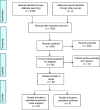A systematic review of treatment for patients with burning mouth syndrome
- PMID: 34404247
- PMCID: PMC8793318
- DOI: 10.1177/03331024211036152
A systematic review of treatment for patients with burning mouth syndrome
Abstract
Background: Burning mouth syndrome is a chronic idiopathic intractable intraoral dysaesthesia that remains a challenge to clinicians due to its poorly understood pathogenesis and inconsistent response to various treatments.
Aim: This review aimed to study the short- (≤3 months) and long-term (>3 months) effectiveness and sustainable benefit of different burning mouth syndrome treatment strategies and the associated side effects.
Materials and methods: Randomised controlled trials of burning mouth syndrome treatment compared with placebo or other interventions with a minimum follow up of 2 months were searched from the PubMed, Embase and Cochrane database (published to July 2020).
Results: Twenty-two studies were selected based on the inclusion and exclusion criteria and analysed. Nine categories of burning mouth syndrome treatment were identified: Anticonvulsant and antidepressant agents, phytomedicine and alpha lipoic acid supplements, low-level laser therapy, saliva substitute, transcranial magnetic stimulation, and cognitive behaviour therapy. Cognitive behaviour therapy, topical capsaicin and clonazepam, and laser therapy demonstrated favourable outcome in both short- and long-term assessment. Phytomedicines reported a short-term benefit in pain score reduction. The pooled effect of alpha lipoic acid (ALA) pain score improvement was low, but its positive effects increased in long term assessment.
Conclusion: A more significant volume in terms of sample size, multi-centres, and multi-arm comparison of therapeutic agents with placebo and longitudinal follow-up studies is recommended to establish a standardised burning mouth syndrome treatment protocol. Further studies are required to assess the analgesic benefits of topical clonazepam and capsaicin, alternative medicines with neurodegenerative prevention capability and psychology support in treating burning mouth syndrome and reducing systemic adverse drug reactions.Registration International Prospective Register of Systematic Reviews (PROSPERO):Protocol ID - CRD42020160892.
Keywords: Burning mouth syndrome; glossodynia; systematic review; treatment.
Conflict of interest statement
Figures





Similar articles
-
Interventions for the treatment of burning mouth syndrome.Cochrane Database Syst Rev. 2005 Jan 25;(1):CD002779. doi: 10.1002/14651858.CD002779.pub2. Cochrane Database Syst Rev. 2005. Update in: Cochrane Database Syst Rev. 2016 Nov 18;11:CD002779. doi: 10.1002/14651858.CD002779.pub3. PMID: 15674897 Updated.
-
Burning mouth syndrome: a systematic review of treatments.Oral Dis. 2018 Apr;24(3):325-334. doi: 10.1111/odi.12660. Epub 2017 Mar 30. Oral Dis. 2018. PMID: 28247977
-
Interventions for the treatment of burning mouth syndrome.Cochrane Database Syst Rev. 2001;(3):CD002779. doi: 10.1002/14651858.CD002779. Cochrane Database Syst Rev. 2001. Update in: Cochrane Database Syst Rev. 2005 Jan 25;(1):CD002779. doi: 10.1002/14651858.CD002779.pub2. PMID: 11687027 Updated.
-
Selegiline for Alzheimer's disease.Cochrane Database Syst Rev. 2003;(1):CD000442. doi: 10.1002/14651858.CD000442. Cochrane Database Syst Rev. 2003. PMID: 12535396
-
Laser therapy for treating hypertrophic and keloid scars.Cochrane Database Syst Rev. 2022 Sep 26;9(9):CD011642. doi: 10.1002/14651858.CD011642.pub2. Cochrane Database Syst Rev. 2022. PMID: 36161591 Free PMC article.
Cited by
-
Oral manifestations serve as potential signs of ulcerative colitis: A review.Front Immunol. 2022 Sep 29;13:1013900. doi: 10.3389/fimmu.2022.1013900. eCollection 2022. Front Immunol. 2022. PMID: 36248861 Free PMC article. Review.
-
Evaluating the Impact of Different Treatments on the Quality of Life in Patients With Burning Mouth Syndrome: A Scoping Review.Cureus. 2024 Sep 29;16(9):e70419. doi: 10.7759/cureus.70419. eCollection 2024 Sep. Cureus. 2024. PMID: 39473642 Free PMC article.
-
Challenges of Diagnosis and Management of Burning Mouth Syndrome: A Literature Review.Curr Aging Sci. 2025;18(2):102-119. doi: 10.2174/0118746098279205240812113353. Curr Aging Sci. 2025. PMID: 40289359 Review.
-
Comprehensive analysis of the oral microbiota and metabolome change in patients of burning mouth syndrome with psychiatric symptoms.J Oral Microbiol. 2024 Jun 3;16(1):2362313. doi: 10.1080/20002297.2024.2362313. eCollection 2024. J Oral Microbiol. 2024. PMID: 38835338 Free PMC article.
-
Long-Term Benefits of Photobiomodulation Therapy on Health-Related Quality of Life in Burning Mouth Syndrome Patients: A Prospective Study.J Clin Med. 2024 Jul 22;13(14):4272. doi: 10.3390/jcm13144272. J Clin Med. 2024. PMID: 39064312 Free PMC article.
References
-
- International Classification of Orofacial Pain, 1st edition (ICOP). Cephalalgia 2020; 40(2): 129-221. - PubMed
-
- Bergdahl M, Bergdahl J. Burning mouth syndrome: Prevalence and associated factors. J Oral Pathol Med 1999; 28: 350–354. - PubMed
-
- Scala A, Checchi L, Montevecchi M, et al.. Update on burning mouth syndrome: Overview and patient management. Crit Rev Oral Biol Med 2003; 14: 275–291. - PubMed
-
- Forssell H, Teerijoki-Oksa T, Kotiranta U, et al. . Pain and pain behavior in burning mouth syndrome: A pain diary study. J Orofac Pain 2012; 26: 117–125. - PubMed
Publication types
MeSH terms
Substances
Grants and funding
LinkOut - more resources
Full Text Sources
Medical

